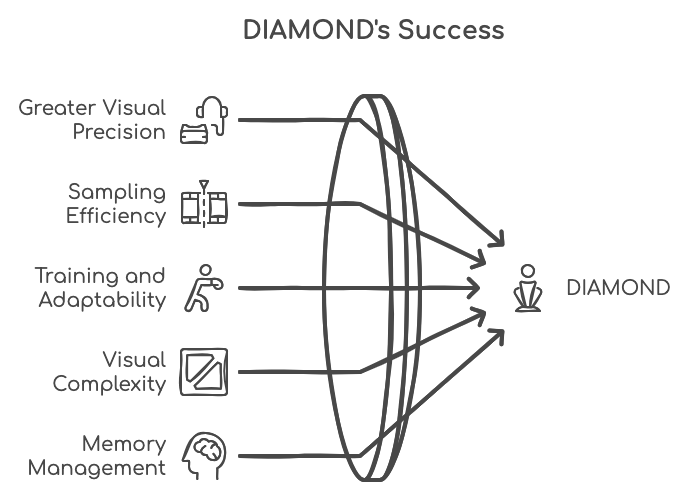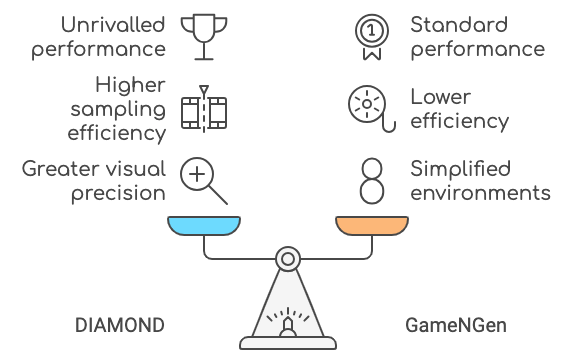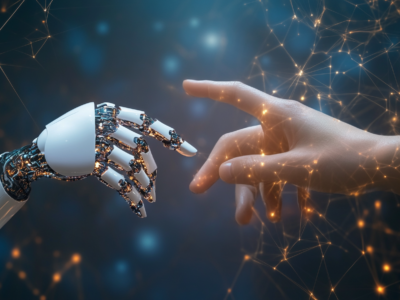The field of video games has always been fertile ground for innovation, but the rise of AI promises to disrupt this universe even further. Today, one of the most fascinating advances in this field is the use of diffusion models, which enable artificial intelligences to create and interact with virtual environments in real time.
Among these emerging technologies, DIAMOND (DIffusion As a Model Of eNvironment Dreams) game engine is pushing the envelope.
Listen to the AI podcast :
Designed to predict the evolution of game images based on player actions, DIAMOND redefines the way reinforcement learning (RL) agents train in simulated environments, while pushing the limits of visual capabilities and realism.
How DIAMOND works
At the heart of DIAMOND is a diffusion model, a type of neural network designed to generate images based on iterative processes.
To put it simply, imagine DIAMOND “observing” the evolution of the game frame by frame and predicting what’s going to happen based on the player’s actions.
This process relies on a technique called “bruitage,” which involves adding visual noise to an image to distort it slightly, then training the model to reconstruct the original image.
This method allows DIAMOND to learn how to rcreate realistic game scenes using only noisy visual information.
By progressively denoising the images, he creates a fluid, coherent sequence of images, simulating the evolution of the video game.
This image generation process continues step by step, until a complete simulation of the virtual world is produced.
DIAMOND highlights
DIAMOND stands out for several major advantages over traditional virtual world simulation models.

Increased visual precision
In contrast to other models that simplify environments by converting them into symbolic data, DIAMOND processes image pixels directly.
For example, imagine a game where every detail, from wall texture to light reflections, is meticulously generated.
It’s this precision that enables DIAMOND to recreate environments with unrivalled visual fidelity.
Sampling efficiency
Thanks to its diffusion algorithm, DIAMOND can generate realistic images with a limited number of denoising steps.
This means that training RL agents is faster, as they don’t need huge amounts of computation to simulate actions.
This could be compared to a film director who manages to create realistic special effects with a reduced number of renders, saving time and resources.
Unmatched performance
DIAMOND has already broken records on standard tests such as the Atari 100k.
For video game enthusiasts, this means that DIAMOND-based AIs can outperform humans in many games, while being trained solely in a virtual environment.
Comparison with GameNGen
The GameNGen technology developed by Google DeepMind also uses broadcast models to predict game environments, but several aspects distinguish DIAMOND.

Training and adaptability
GameNGen requires vast gameplay datasets to perform, which requires enormous resources.
DIAMOND, on the other hand, is designed to work with smaller datasets, making it more agile and adaptable to a wider variety of games, especially those requiring highly detailed or specific environments.
Visual complexity
While GameNGen was tested on Doom, a game with a less sophisticated visual style, DIAMOND proved its effectiveness on more modern titles such as Counter-Strike: Global Offensive (CS:GO).
This proves that DIAMOND is capable of reproducing more complex environments at much higher graphic resolutions.
Memory management
One of GameNGen’s limitations is its short-term memory, limited to just three seconds of history.
This can sometimes lead to inconsistencies in generated scenes.
DIAMOND seems to have circumvented this difficulty, although further research is needed to verify how far this flexibility in memory can go.
Potential of the technology behind DIAMOND
Beyond video games, DIAMOND could have a significant impact in many other sectors.
In the field of training, for example, ultra-realistic simulations could allow doctors to train for complex surgeries, or pilots to prepare for emergencies in simulated environments, without any physical risk.
In the therapy sector, DIAMOND could be used for immersive therapies to treat phobias, post-traumatic stress disorder (PTSD) or rehabilitation programs.
Thanks to its ability to generate hyper-realistic environments, it would enable patients to be immersed in specific situations in a controlled, progressive manner.
In addition, for independent video game creators, the technology could democratize access to advanced creative tools.
Rather than having to code every element of a game, developers could rely on AI environment generators like DIAMOND to design immersive worlds faster and cheaper.
Conclusion
DIAMOND isn’t just a breakthrough in video game creation, it’s a revolution in the way artificial intelligences can interact with complex environments.
Although its development is still in progress, it paves the way for major innovations in fields as diverse as training, therapy, or artistic creation.
FAQ
- What is DIAMOND and what is it used for?
DIAMOND is an artificial intelligence-based video game engine that uses diffusion models to predict and generate environments based on player actions. - How does diffusion technology work in DIAMOND?
Diffusion involves training a model to reverse a visual noise process, enabling it to recreate images from noisy images and generate realistic game environments. - What are the main differences between DIAMOND and GameNGen?
DIAMOND stands out for its adaptability to smaller datasets and its ability to handle more visually complex games, whereas GameNGen has memory limitations. - In what other sectors could DIAMOND be used?
DIAMOND could be used in fields such as training, simulation, education, and immersive therapy. - What are the advantages of DIAMOND over other AI-based models?
DIAMOND offers better visual accuracy, superior sampling efficiency, and record performance in simulation environments. - Can DIAMOND work with small datasets?
Yes, unlike other systems like GameNGen, DIAMOND can be trained on smaller datasets, making it more flexible. - What games have been tested with DIAMOND?
DIAMOND has been successfully tested on modern games such as Counter-Strike: Global Offensive (CS:GO). - How does DIAMOND handle real-time image generation?
DIAMOND uses an iterative diffusion process to generate images at each stage, enabling the simulation of a game environment in real time. - Could DIAMOND be used in the medical field?
Absolutely. DIAMOND could be used to create ultra-realistic simulations for medical training, particularly for surgeons or emergency situations. - What are the current challenges facing DIAMOND?
Although promising, DIAMOND is still in the development phase. Improvements in memory management and performance are needed to reach its full potential.
AI NEWSLETTER
Stay on top of AI with our Newsletter
Every month, AI news and our latest articles, delivered straight to your inbox.

CHATGPT prompt guide (EDITION 2024)
Download our free PDF guide to crafting effective prompts with ChatGPT.
Designed for beginners, it provides you with the knowledge needed to structure your prompts and boost your productivity
With this ebook, you will:
✔ Master Best Practices
Understand how to structure your queries to get clear and precise answers.
✔ Create Effective Prompts
The rules for formulating your questions to receive the best possible responses.
✔ Boost Your Productivity
Simplify your daily tasks by leveraging ChatGPT’s features.
Similar posts
GameNGen and DOOM AI: Video games generated in real time
Soon video games may no longer be programmed line by line by developers, but generated in real time by an AIcapable of creating dynamic interactive environments unique to each game. …
Cursor AI: the AI that will change developers’ lives
Cursor AI is revolutionizing software development by seamlessly integrating artificial intelligence into the code editor. The app combines the power of AI chatbots and an advanced code editor, enabling anyone …
ChatGPT Canvas : The new interface for writing and coding with ChatGPT
You thought OpenAI was on the wane? 😉 After recent announcements that may have disappointed some people’s expectations, OpenAI continues to push the boundaries of its chat tool, with the …


